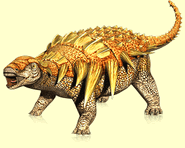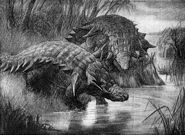No edit summary |
Disneysaurus (talk | contribs) No edit summary Tag: sourceedit |
||
| (13 intermediate revisions by 9 users not shown) | |||
| Line 1: | Line 1: | ||
| + | [[File:667645831_orig.png|thumb]]''Edmontonia'' would not have made an easy meal for a hungry tyrannosaur. It had a heavily armored body and large, forward-pointing shoulder spines. We know what ''Edmontonia'' looked like because two specimens were found with their armor and spikes preserved in the position they had in life. The bodies of these specimens may have dried out because of a drought and then been quickly covered by sediment when the rainy season began. Evidence for these changes in the climate is found in the growth rings of fossil wood. |
||
| − | == Intro == |
||
| − | [[File:Edmontonia1201807274.jpg|thumb|267px]] '''Edmontonia''' was an aromored dinosaur that lived in the late Creataceous Period. It was a distant relative of [[Ankylosaurus]]. Only partial skeletons have ever been found, and ''Edmontonia '' |
||
| + | ''Edmontonia'' walked on four legs and was a plant-eater. It had a pear-shaped skull (when viewed from the top). The neck and part of the back were protected by large, flat, keeled (ridged) plates. Smaller keeled plates covered the back, hips, and tail. Spines and large spikes along its sides would have made the animal look short and wide when viewed from the front. This made it look more menacing to an enemy. |
||
| − | remains not well known. |
||
| + | An ''[[Albertosaurus]]'' was not the only animal it needed to protect itself from. A male ''Edmontonia'' probably fought with other males for territory and females. The larger males may have used their large shoulder spines for shoving contests. The spines of ''Edmontonia'' would have been dangerous to rival males or to an Albertosaurus or ''[[Daspletosaurus]]'', if they got too close. |
||
| − | == Fact File == |
||
| + | Like other ankylosaurs, ''Edmontonia'' most likely spent most of its life alone. It was nearly completely covered in armor, with only its soft underbelly left unprotected. If a predator like ''Albertosaurus'' came by, it just tucked itself as close as it could to the ground and wait for the tyrannosaur to pass. Along with armor, ''Edmontonia'' also had long, sharp, scissor-like spikes along its shoulders, some growing to be nearly a foot and a half (46 cm.) long. It had a thick, tank-like body with stout, slow legs. It didn't have a club on the end of its tail like its more famous cousins [http://dinosaurs.wikia.com/wiki/Ankylosaurus ''Ankylosaurus''] and ''[http://dinosaurs.wikia.com/wiki/Euoplocephalus Euoplocephalus]'', but it ended in more like a sharp, bony whip, probably good for whapping tyrannosaur legs and making them back-off. |
||
| − | length: 6.6 metres |
||
| + | ==In Popular Culture== |
||
| − | |||
| + | ''Edmontonia'' is featured in <u>March of the Dinosaurs</u>, where one lives up in the Arctic Circle along with a herd of ''Edmontosaurus'' and ''Pachyrhinosaurus''. When the other two herds migrate South to escape the freezing winter, the ''Edmontonia'' stays behind and slips in the snow while trying to get some food, and is flipped over onto its back, unable to flip itslef back over. It was nearly killed by a pack of ''Troodon'' and a ''[http://dinosaurs.wikia.com/wiki/Gorgosaurus Gorgosaurus]'', but the tyrannosaur flips it while trying to take the ankylosaur from the ''Troodon'', and the nodosaur mortally wounds it. It then continued on its way and continued to live on as the herds returned. An ''Edmontonia'' appears in <u>Life After Dinosaurs</u> where it is shown inaccurately to live in South America. |
||
| − | height: 2 metres |
||
| + | ==Gallery== |
||
| − | |||
| + | <gallery> |
||
| − | weight: not known |
||
| + | Edmontonia |
||
| − | |||
| + | Karen_Carr_Royal_Tyrrell_Edmontia_detail.jpg |
||
| − | Diet: [[Herbivore|herbivorous]] |
||
| + | edskel.jpg|Edmontonia Skeleton |
||
| − | |||
| + | ed-vs-dapleto.jpg|Edmontonia vs. Daspletosaurus |
||
| − | == Prey == |
||
| + | 120edmontonia.jpg |
||
| − | ''Edmontonia'' would have fed on low lying vegetation. |
||
| + | 225px-Edmontonia_model.jpg |
||
| + | Edmontia_nagoya.gif |
||
| + | dino1_2012622b.jpg|March of the Dinosaurs Edmontonia |
||
| + | Edmontonia_SIZE.jpg|Edmontonia Size Scale |
||
| + | Edmontonia 6394.JPG |
||
| + | Edmontonia restoration.jpg |
||
| + | Schleich Edmontonia.JPG |
||
| + | Ethyl Phillips.jpg|Ethyl Phillips is a Edmontonia |
||
| + | </gallery> |
||
| + | [[Category:Dinosaurs]] |
||
[[Category:Herbivores]] |
[[Category:Herbivores]] |
||
| + | [[Category:Cretaceous]] |
||
| + | [[Category:Dinosaurs of North America]] |
||
| + | [[Category:Ankylosaurians]] |
||
Revision as of 23:11, 11 September 2015

Edmontonia would not have made an easy meal for a hungry tyrannosaur. It had a heavily armored body and large, forward-pointing shoulder spines. We know what Edmontonia looked like because two specimens were found with their armor and spikes preserved in the position they had in life. The bodies of these specimens may have dried out because of a drought and then been quickly covered by sediment when the rainy season began. Evidence for these changes in the climate is found in the growth rings of fossil wood.
Edmontonia walked on four legs and was a plant-eater. It had a pear-shaped skull (when viewed from the top). The neck and part of the back were protected by large, flat, keeled (ridged) plates. Smaller keeled plates covered the back, hips, and tail. Spines and large spikes along its sides would have made the animal look short and wide when viewed from the front. This made it look more menacing to an enemy.
An Albertosaurus was not the only animal it needed to protect itself from. A male Edmontonia probably fought with other males for territory and females. The larger males may have used their large shoulder spines for shoving contests. The spines of Edmontonia would have been dangerous to rival males or to an Albertosaurus or Daspletosaurus, if they got too close. Like other ankylosaurs, Edmontonia most likely spent most of its life alone. It was nearly completely covered in armor, with only its soft underbelly left unprotected. If a predator like Albertosaurus came by, it just tucked itself as close as it could to the ground and wait for the tyrannosaur to pass. Along with armor, Edmontonia also had long, sharp, scissor-like spikes along its shoulders, some growing to be nearly a foot and a half (46 cm.) long. It had a thick, tank-like body with stout, slow legs. It didn't have a club on the end of its tail like its more famous cousins Ankylosaurus and Euoplocephalus, but it ended in more like a sharp, bony whip, probably good for whapping tyrannosaur legs and making them back-off.
In Popular Culture
Edmontonia is featured in March of the Dinosaurs, where one lives up in the Arctic Circle along with a herd of Edmontosaurus and Pachyrhinosaurus. When the other two herds migrate South to escape the freezing winter, the Edmontonia stays behind and slips in the snow while trying to get some food, and is flipped over onto its back, unable to flip itslef back over. It was nearly killed by a pack of Troodon and a Gorgosaurus, but the tyrannosaur flips it while trying to take the ankylosaur from the Troodon, and the nodosaur mortally wounds it. It then continued on its way and continued to live on as the herds returned. An Edmontonia appears in Life After Dinosaurs where it is shown inaccurately to live in South America.

